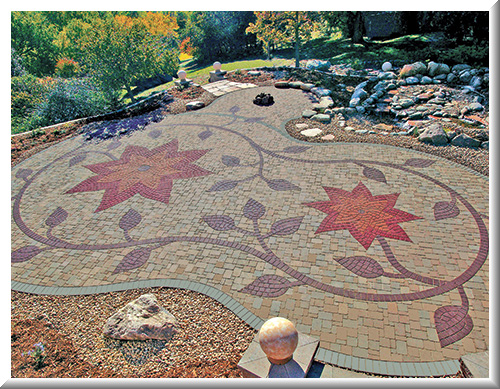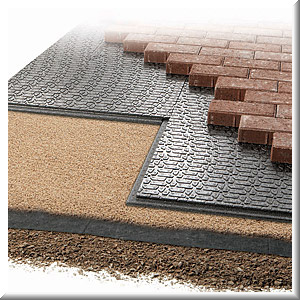Landscape
 Nearly every hardware or garden store seems to have an abundance of options when it comes to paver selection. Between the styles, sizes, shapes and colors you can create nearly any look you can possibly dream up. As you go out and tackle a paver project on your own or have a contractor put one in for you there are a few things that you should be aware of.
Nearly every hardware or garden store seems to have an abundance of options when it comes to paver selection. Between the styles, sizes, shapes and colors you can create nearly any look you can possibly dream up. As you go out and tackle a paver project on your own or have a contractor put one in for you there are a few things that you should be aware of.
Simply picking out a paver that looks good is not the last step to building a quality walk, patio or drive. Before you choose the perfect paver because it looks good, you must also keep in mind: how the paver was constructed and what the application you are using it for. Different manufacturers can vary not only the ingredients but the process by which the paver is made. In an effort to keep costs down a manufacturer may minimize the amount of Portland cement and aggregate. They can also modify the way a paver is cured, creating a paver that may have a slightly higher moisture content, making it a less durable product.
All pavers must meet ICPI (Interlocking Concrete Paver Institute) standards. While these are necessary to keep paver products consistent in North America, there are manufacturers that will go above the set standards and create a much more durable product. As a company we install pavers that exceed the ICPI’s standards and suggest if you are looking to install your own paver surface, do the same. Borgert and Belgard are two companies that have been manufacturing pavers for many years and pride themselves on the level of quality they reach in their pavers. There are certainly more companies that create a high quality paver, but be aware of the inexpensive option you may find at your local hardware store.
As important as the paver quality is, the preparation of the site is equally if not more important. Starting at bottom with the sub grade (native soil), it must be prepped level and mechanically compacted to create a solid base for your pavers. Typically for a walk or patio you will need to excavate approximately 9 inches below your expected finished grade to set your sub grade level (a drive would be closer to a foot or more). A plate compactor should be run over the base area in two different directions, multiple times to ensure proper compaction. Smaller areas can be hand tamped and if necessary a jumping jack can be used near foundations to ensure settling does not affect your finished product. Once the sub base is compacted and level you will install a geo textile fabric over the soil, overlapping the edges. Clean road base set in two inch increments (lifts) will go down next, leveled and compacted with a plate compactor just like the sub base. This will continue until you get your four to six inch base (walk or patio) done. At this point you will level the road base exactly as the top surface will sit. For example if you want the water to shed away from the house at ¼” per foot, the road base must mimic this. After the road base is level and set, a one inch layer of clean washed sand is screeded out to set the pavers on. You can screed over ¾” steel pipe to get a uniform depth. Pavers are now set on the sand (do not disturb the sand) in the desired pattern, gaps are cut in and your edge restraint is pinned in on the edges. Clean washed sand is swept into the joints and once again the plate compactor is run in two directions over the entire surface to compact and set pavers. Sand may be swept in after compacting to fill gaps. A quality product and process will ensure many years of a trouble free hardscape.
is equally if not more important. Starting at bottom with the sub grade (native soil), it must be prepped level and mechanically compacted to create a solid base for your pavers. Typically for a walk or patio you will need to excavate approximately 9 inches below your expected finished grade to set your sub grade level (a drive would be closer to a foot or more). A plate compactor should be run over the base area in two different directions, multiple times to ensure proper compaction. Smaller areas can be hand tamped and if necessary a jumping jack can be used near foundations to ensure settling does not affect your finished product. Once the sub base is compacted and level you will install a geo textile fabric over the soil, overlapping the edges. Clean road base set in two inch increments (lifts) will go down next, leveled and compacted with a plate compactor just like the sub base. This will continue until you get your four to six inch base (walk or patio) done. At this point you will level the road base exactly as the top surface will sit. For example if you want the water to shed away from the house at ¼” per foot, the road base must mimic this. After the road base is level and set, a one inch layer of clean washed sand is screeded out to set the pavers on. You can screed over ¾” steel pipe to get a uniform depth. Pavers are now set on the sand (do not disturb the sand) in the desired pattern, gaps are cut in and your edge restraint is pinned in on the edges. Clean washed sand is swept into the joints and once again the plate compactor is run in two directions over the entire surface to compact and set pavers. Sand may be swept in after compacting to fill gaps. A quality product and process will ensure many years of a trouble free hardscape.
